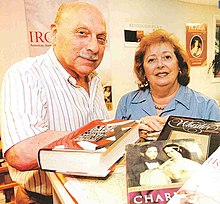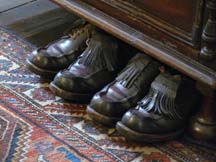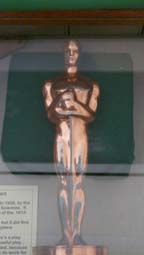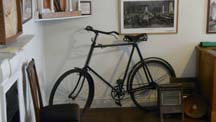Professor Charles Carpenter is a great authority on Shaw Bibliography.
Please click here for Professor Charles Carpenter’s authoritative Shaw Bibliography.
—————————————————————————
NEW!!
Charles (Al) Carpenter, Bernard Shaw’s Letters to Individuals:
A Chronological Selection of Wholes and Parts Duplicated from A Great Variety of Sources into a Downloadable, Searchable, Readable WORD File.
Contains a host of letters and parts of letters that you have never seen before.
The 600-plus page file will cost $30 for all but people still pursuing their advanced degrees, for whom it will cost $20. The British equivalents are £20 and £15; checks or bills for these amounts will be welcomed. Periodic updates will be sent with no additional charge.
To purchase the file, send the fee to me at908 Lehigh Ave.,VestalNY13850. I will need a note from everyone containing your name and email address. Please respect my efforts and do not send a copy of your file to anyone else.
Alphabetical List of Sources with two or more letters (many others have one)
Archer: Archer, Charles. William Archer: Life, Work, and Friendships. 1931
Astor: Bernard Shaw and Nancy Astor. Ed. J. P. Wearing. 2005
Barker: Bernard Shaw’s Letters to Granville Barker. Ed. C. B. Purdom. 1956
Barnes: Barnes, Kenneth R. Welcome, Good Friends: The Autobiography of Kenneth R. Barnes. 1958
Bax: Bax, Clifford, ed. Florence Farr, Bernard Shaw, W.B. Yeats: Letters. 1942
Beaumont: Huggett, Richard. Binkie Beaumont: Eminence Grise of the West End Theatre 1933-1973. 1989
Bright: Bright, R. E. Golding. Advice to a Young Critic, and Other Letters. Ed. E. J. West. 1955
Brockway: Brockway, Fenner. Outside the Right: A Sequel to Inside the Left, with a Lost Play by G. Bernard Shaw. 1963
Caine: Allen, Vivian. Hall Caine: Portrait of a Victorian Romancer. 1997
Calvert: Calvert, Adelaide Helen. Sixty-Eight Years on the Stage. 1911
Campbell: Bernard Shaw and Mrs. Patrick Campbell: Their Correspondence. 1952
Chappelow: Chappelow, Allan. Shaw the Villager and Human Being: A Biographical Symposium. 1962.
Cockerell: Cockerell, Sydney Carlyle. The Best of Friends: Further Letters to Sydney Carlyle Cockerell. Ed. Viola Meynell. 1956
Cohen: Cohen, Harriet. A Bundle of Time: The Memoirs of Harriet Cohen. 1969
Conolly: Conolly, L. W. Bernard Shaw and the BBC. 2009
Cornwallis-West: Quelch, Eileen. Perfect Darling: The Life and Times of George Cornwallis-West. 1972
Devlin: Devlin, Diana. A Speaking Part: Lewis Casson and the Theatre of His Time. 1982
Dickens: Laurence, Dan H., and Martin Quinn, eds. Shaw on Dickens. 1985
Douglas: Bernard Shaw and Alfred Douglas: A Correspondence. Ed. Mary Hyde. 1982
Dunbar: Dunbar, Janet. Mrs. G.B.S.: A Portrait. 1963
Egerton: Egerton, George. A Leaf from The Yellow Book. 1958
Elgar: Elgar, Edward. Letters of a Lifetime. Ed. Jerrold Northrop Moore. 1990
Elliot: Elliot, Vivian, ed. Dear Mr Shaw: Selections from Bernard Shaw’s Postbag. 1987
Ervine: Ervine, St. John. Bernard Shaw: His Life, Work and Friends. 1956
Evans: Forbes, Bryan. Ned’s Girl: The Authorized Biography of Dame Edith Evans. 1977
Farleigh: Farleigh, John. Graven Image: An Autobiographical Textbook. 1940
Gregory: Gregory, Lady Augusta. Shaw, Lady Gregory and the Abbey: A Correspondence and a Record. Ed. Dan H. Laurence and Nicholas Grene. 1993
Hamon: George Bernard Shaw et Augustin Hamon: les premiers temps d’une correspondance (1893-1913). Ed. Patrick Galliou. 4 vols. 1998
Hardwicke: Hardwicke, Cedric. A Victorian in Orbit: The Irreverent Memoirs of Sir Cedric Hardwicke. 1961
Harris: The Playwright and the Pirate: Bernard Shaw and Frank Harris: A Correspondence. Ed. Stanley Weintraub. 1982
Henderson 1: Henderson, Archibald. Bernard Shaw: Playboy and Prophet. 1932
Henderson 2: Henderson, Archibald. George Bernard Shaw: Man of the Century. 1956
Holroyd: Holroyd, Michael. Bernard Shaw. 4 vols. 1988-92
Hurd: Hurd, Michael. Immortal Hour: The Life and Period of Rutland Boughton. 1962
Jackson: Bernard Shaw and Barry Jackson. Ed. Leonard W. Conolly. 2002
Ker: Ker, Ian. G. K. Chesterton: A Biography. 2011
Lane: Hare, Steve, ed. Penguin Portrait: Allen Lane and the Penguin Editors, 1935-1970. 1995
Lawrence 1: Lawrence, Thomas Edward. Letters to T. E. Lawrence. Ed. A. W. Lawrence. 1962
Lawrence 2: Lawrence, Thomas Edward. Correspondence with Bernard and Charlotte Shaw 1922-1926. Ed. Jeremy and Nicole Wilson. 2000
Loraine: Loraine, Winifred. Robert Loraine: Soldier, Actor, Airman. 1938
McCarthy: McCarthy, Lillah. Myself and My Friends. 1933
McLachlan: Benedictines of Stanbrook. In a Great Tradition: Tribute to Dame Laurentia McLachlan, Abbess of Stanbrook. 1956
McNulty: McNulty, Edward. Memoirs of G.B.S. Ed. Dan H. Lawrence. SHAW 12 (1992): 5-46
Meisel: Meisel, Martin. Shaw and the Nineteenth-Century Theater. 1963
Moore: Moore, Helen M. “George Bernard Shaw and the Bishop’s Daughter.” Carnegie Magazine 59 iv (1988): 22-29
Murray: Bernard Shaw and Gilbert Murray. Ed. Charles A. Carpenter. 2012 (forthcoming; dates of letters included with selected text)
O’Casey 1: O’Casey, Sean. The Letters of Sean O’Casey 1910-41, vol. I. Ed. David Krause. 1975
O’Casey 2: O’Casey, Eileen. Cheerio, Titan: The Friendship Between George Bernard Shaw and Eileen and Sean O’Casey. 1989
Page: Page, Will A. Beyond the Curtains of the Broadway Beauty Trust. 1927
Park: Park, Julian, ed. “Some Unpublished Letters by George Bernard Shaw.” University of Buffalo Studies, 1939
Pascal: Bernard Shaw and Gabriel Pascal. Ed. Bernard F. Dukore. 1996
Pearson: Pearson, Hesketh. Bernard Shaw: His Life and Personality. 1963
Peters 1: Peters, Margot. Bernard Shaw and the Actresses. 1980
Peters 2: Peters, Margot, ed. Shaw on Women. 1992
Pharand: Pharand, Michel W. Bernard Shaw and the French. 2000
Publishers: Bernard Shaw and His Publishers. Ed. Michel W. Pharand. 2009
Rhys: Rhys, Ernest. Letters from Limbo. 1936
Richards: Grant Richards. Author Hunting. 1934
Robson: Belmont, Eleanor Robson. The Fabric of Memory. 1957
Russell: Russell, Bertrand. The Autobiography of Bertrand Russell, 1914-1944. 1968
Samuel: Laurence, Dan H. “Katie Samuel: Shaw’s Flameless ‘Old Flame.’” SHAW 15 (1995): 3-19
Soboleva: Soboleva, Olga, and Angus Wrenn. The Only Hope of the World: George Bernard Shaw and Russia. 2012
Somerville: Rauchbauer, Otto. The Edith Œnone Somerville Archive in Drishane. 1995
Terry: Ellen Terry and Bernard Shaw: A Correspondence.Ed. Christopher St. John. 1931
Theatrics: Theatrics. Ed. Dan H. Laurence. 1995
Thompson: E. P. Thompson. William Morris, Romantic to Revolutionary. 2nd ed. 1977
Tompkins: To a Young Actress: The Letters of Bernard Shaw to Molly Tompkins. Ed. Peter Tompkins. 1961
Trebitsch 1: Bernard Shaw’s Letters to Siegfried Trebitsch. Ed. Samuel A. Weiss. 1986
Trebitsch 2: “Bernard Shaw’s Further Letters to Siegfried Trebitsch.” Ed. Samuel A. Weiss. SHAW 20 (2000): 220-44
Tunney: Tunney, Jay R. The Prizefighter and the Playwright: Gene Tunney and Bernard Shaw. 2011
Ward: Ward, Maisie. Gilbert Keith Chesterton. 1943
Webbs: Webb, Stanley and Beatrice. Bernard Shaw and the Webbs. Ed. Alex C. Michalos and Deborah C. Poff. 2002
Wells: Bernard Shaw and H. G. Wells. Ed. J. Percy Smith. 1995
Wheeler: Wheeler, Margaret. Letters from Margaret: Correspondence Between Bernard Shaw and Margaret Wheeler 1944-1950. 1992
Winsten: Winsten, Stephen. Jesting Apostle: The Private Life of Bernard Shaw. 1957
Wisenthal: Wisenthal, J. L. Shaw’s Sense of History. 1988
















